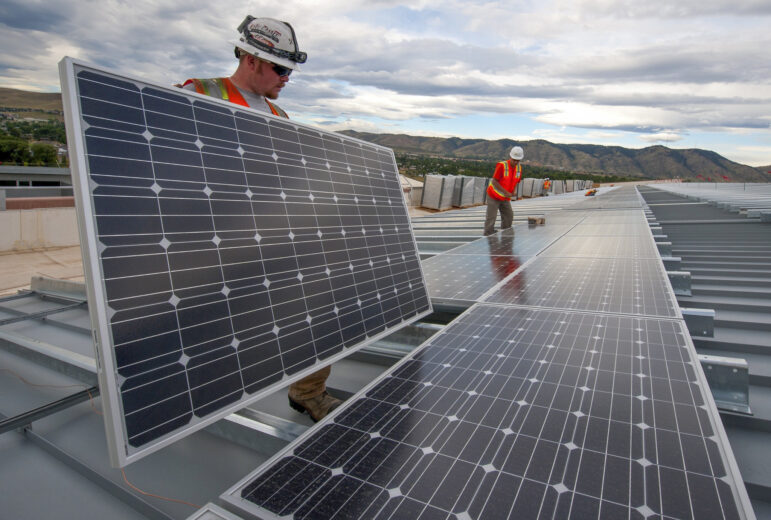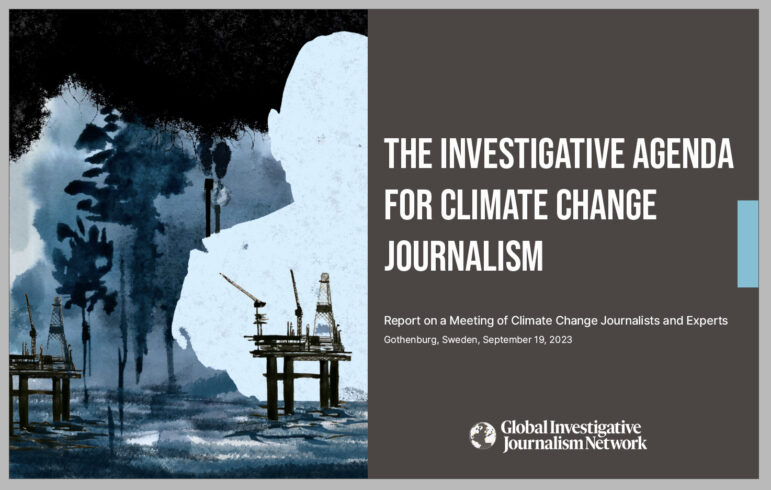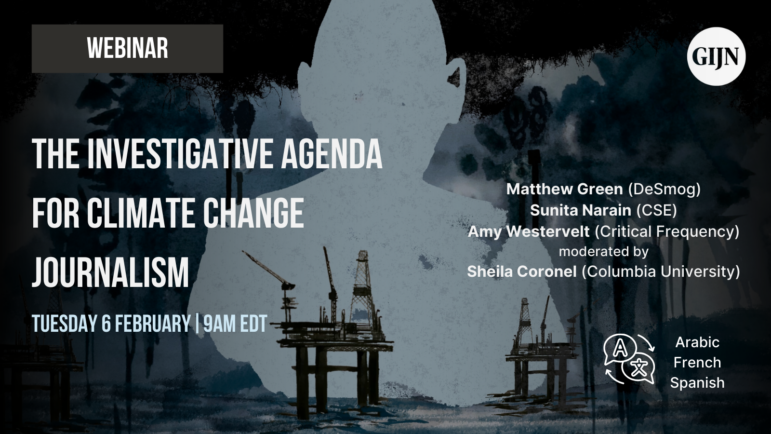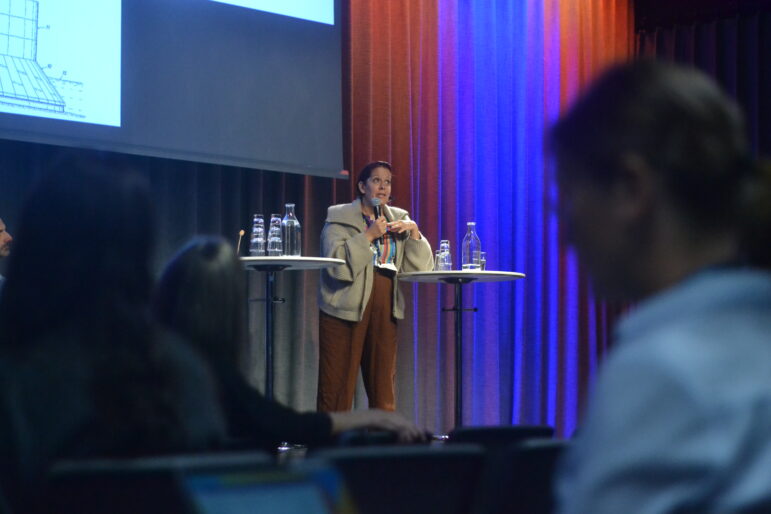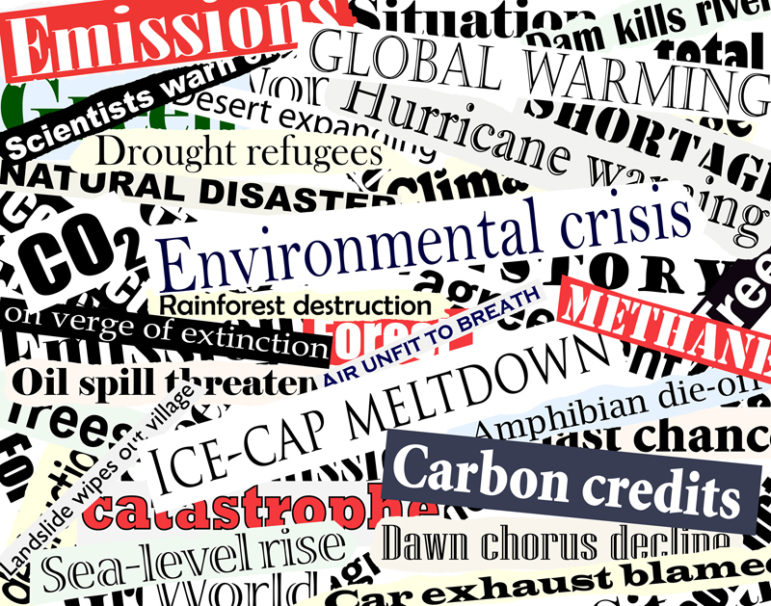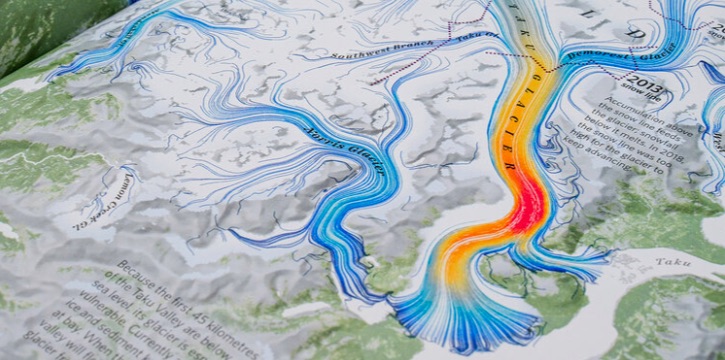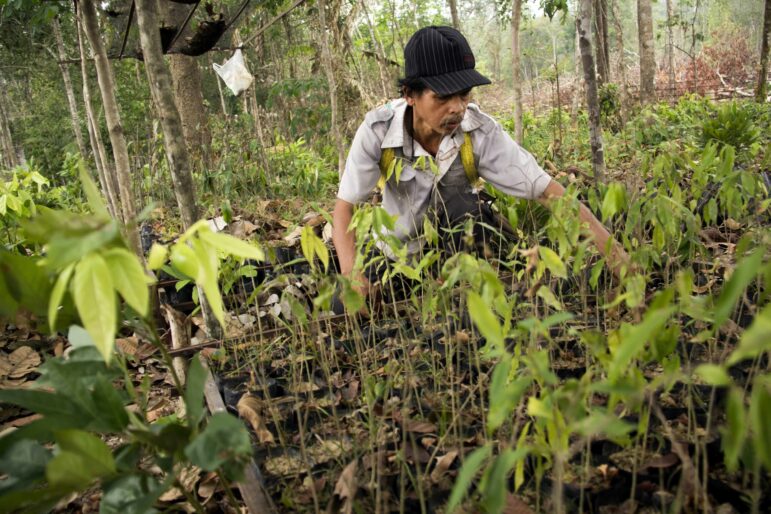

A man tending to a nursery in the East Kalimantan Province of Indonesia, as part of a reforestation project. Image: ClimateVisuals.org, Michael Elko
Reporter’s Guide to Investigating Carbon Offsets
Read this article in
“Carbon offsetting” is a controversial tool in the fight against global heating. Oversight by journalists is essential and has already had a major impact. It’s an important, though not easy, assignment. But there are many stories to be done worldwide, from the local level to the corporate boardroom.
Carbon offsetting is possible when a project that reduces greenhouse gas emissions is turned into a saleable commodity: “carbon credits.” These credits may be used by the purchaser to “offset” their own emissions.
The “voluntary market” of trade in carbon credits grew rapidly, but then hit a rough patch, largely because of questions about the credibility of some of the underlying projects. The voluntary marketplace operates virtually without regulation and with limited transparency, although reforms may be on the horizon. As a result, carbon offsets are increasingly under the microscope. Many opportunities exist for investigative journalism.
Investigations can be conducted on a number of fronts: whether carbon offset projects are valid, who is benefiting, and who is not.
It’s a truly international story and there is potential for collaboration between journalists in the Global North and Global South. Most offset projects are created in the developing world but the credits are sold and used by companies in the developed world. Not only are the creators of offsets responsible, but so too are the companies who purchase offsets.
This GIJN guide will explain:
- Part 1: What are carbon offsets.
- Part 2: Where and how to research offsets.
- Part 3: Investigating the validity of offset projects, and other potential stories.
Along the way, we’ll point to many resources on the subject and provide research tips.
Also, GIJN has created a list of investigative stories about carbon offsets, see this corresponding database.
Part I: What Are Carbon Offsets
The basic concept of carbon offsets is fairly straightforward.
“Put simply, carbon offsets involve an entity that emits greenhouse gasses into the atmosphere paying for another entity to pollute less,” wrote Carbon Brief in In-Depth Q&A: Can ‘Carbon Offsets’ Help to Tackle Climate Change?
Start with planting a tree. Because trees absorb and store carbon dioxide (CO2), planting more of them can offset greenhouse gas (GHG) emissions. The amount of carbon dioxide absorbed by the new trees can be quantified, as a carbon credit, and then bought and sold.
Each carbon credit represents one metric ton of CO2 emissions either avoided or removed from the atmosphere. If another greenhouse gas is involved, such as methane, a “carbon dioxide equivalent” is calculated, based on the global warming potential of the other greenhouse gas.
Offset projects come in many shapes and sizes. Some others include: introducing cleaner cooking stoves, using more sustainable farming techniques, creating more energy with solar and wind power, and preventing methane leaks.
Forestation conservation projects, labeled as REDD+ (Reducing emissions from deforestation and forest degradation in developing countries plus), are the most common type of offset project. REDD+ projects are based on the assumption that a forest would have been chopped down if it wasn’t protected.

A visual graphic explaining how voluntary carbon markets work. Image: Screenshot, Centre for Science and Environment
Quantifying the carbon-reducing value of offsets is very complex. The evaluations depend on predictions about nature, technology, and humans. So the measurement of such variables is critical to the accurate assessment of offsets. There are multiple factors involved.
Even for reforestation, for example, variables include not only the number of trees planted, but also the kind of trees, their growth rate, their lifespan, and the risk that they will be cut down or die prematurely. In one word, will the effort be permanent over the lifespan of the offset, which often runs for decades.
Another layer of complexity arises when offset projects are created for not doing something damaging to the environment, such as by protecting a forest. Evaluating this means dealing with questions such as whether the forest really was at risk of being forested.
There’s some lingo to learn. To be a legitimate offset credit, the benefits achieved by such projects need to be “additional,” meaning that the reduction in CO2 emissions would not have happened in the absence of the project. This is known as “additionality.”
Further, the broader picture needs to be considered. If one forest is saved, will that increase logging in another forest? This is referred to as “leakage.” These concepts need to be explained clearly in context.
A style note: “Carbon credits” refers to the marketable commodity, a saleable asset. “Offset projects” is the usual term for the activity from which credits are based. Credits may or may not be used by purchasers to “offset” their own emissions (offsetting).
Resource Materials on Carbon Offsets
For a deeper education on offsets, here are some great resources.
Carbon Brief created an extensive package of explanatory materials, including a glossary.
The Voluntary Carbon Market in India: Do People and Climate Benefit? by the Centre for Science and Environment includes lots of background and case studies that provide practical investigatory guidance.
The Carbon Offset Guide is from the Carbon Offset Research and Education (CORE), an initiative of the Stockholm Environment Institute (SEI) and Greenhouse Gas Management Institute (GHGMI).
AP Explainer: Forest carbon credits aim to offset pollution, from the Associated Press.
The Ultimate Guide to Carbon Offsetting by Ecostat, one of many companies that buys and sells carbon credits.
The Voluntary Credit Market Explained from the Climate and Land Use Alliance.
What is REDD+? From the United Nations Framework Convention on Climate Change (UNFCCC).
From Crisis to Confidence: Rethinking Integrity in the Voluntary Carbon Market, a report by the Compensate Foundation. Another Compensate report covers what the nascent biodiversity markets can learn from the voluntary carbon market.
2023 All In on Climate: The Role of Carbon Credits in Corporate Climate Strategies, a report by Ecosystem Marketplace.
Nature as a Critical Climate Solution: Busting the Myths Around Nature-Based Solutions, a report by Nature4Climate.
Transparency In Developing Carbon Credits, a four-part series by Climco.
Harvard Business Review, a concise summary.
Motivations for Using and Creating Offsets
There are many reasons why carbon offset projects are created and the resulting offset credits are bought and sold. And many players are involved.
GIJN’s reporting guide focuses on how to investigate the “voluntary credit market” (VCN) — the private sector marketplace in which offsets are the currency.

Many individuals encounter carbon credits as a way to offset the climate impact of their commercial jet travel. Image: Climate Visuals, dsleeter_2000
On a personal level, if you take on a commercial flight, you may want to “offset” the CO2 emitted during your trip from the plane burning jet fuel. You can do so by buying an offset credit equal to the amount of CO2 you created by flying. In theory, your purchase neutralizes the negative climate impact.
You likely will buy it from an intermediary, a carbon credit reseller, but the offset project likely was created by another party, such as the person/entity who planted the trees or was paid to plant the trees. Note: Most developers of offset projects have a profit motive. While offsets may be created anywhere, most originate in the developing world.
Critics are concerned that corporations — including those in the fossil fuel industry — are using carbon credits to avoid reducing their own emissions. In other words, carbon offsets can involve paying others in order to justify business as usual. This perspective is outlined in a report on corporate “greenwashing” by NBC, done in partnership with the Pulitzer Center’s Rainforest Investigations Network.
Some critics advocate a “contributions approach” that downplays the value of offsets in line with the Oxford Offsetting Principles, which begins with the goal: “Prioritize reduction of your own emissions.”
Unregulated Market
The marketplace, known as the voluntary carbon market (VCM), is largely unregulated. There’s no centralized system for the evaluation of offsets. However, there are so-called validation and verification bodies (VVBs), which are third-party entities engaged by developers to examine their claimed offsets.
The growth of this offset market has been rapid of late. In 2021, its value was an estimated US$2 billion. And according to a 2023 report issued by Shell and the Boston Consulting Group, the global voluntary market could reach between US$10 – $40 billion in value by 2030.
Carbon offset projects are certified by carbon ”registries.” One dominant registry, Verra, and three others make up the majority of the market. The registries use quantitative methodologies, sometimes called protocols, to validate the offsets brought to them. The extent to which these methodologies are valid is a key point of controversy and one subject for journalists to investigate. For example, a Guardian investigation in early 2023 concluded that more than 90% of the “forest-related projects validated by Verra did not represent genuine carbon reductions.” Such critiques have lowered valuations of specific credits and negatively affected the overall marketplace.
Once commodified, the credits are purchased, usually by large corporations. Companies may buy credits to help them reach a net zero emissions reduction goal or to bolster their green credentials.
Brokers (such as South Pole, ClimatePartner, Xpansiv, Carbon Neural Group, and myclimate) link up developers with buyers. This list is varied and growing. Consultants exist to help purchasers. Trading platforms and marketplaces, such as Carbon Trade Exchange, also act as intermediaries. The criticisms leveled about the quality of particular offsets has prompted some corporations to scale back their purchases. (For insight into this world, read Heidi Blake’s New Yorker article, The Great Cash-for-Carbon Hustle.)
In addition, there is little price transparency for specific offset credits. Sales typically involve non-disclosure clauses. Carbon Market Watch published a report in 2023 revealing that “90 percent of the intermediaries investigated did not disclose the exact fees they charged and/or the profit margins they made.”
The market determines the value of offsets, with the prices (which have fallen of late) dependent on factors including demand, supply, location, and the type of offset.
What’s more, an offset may be traded multiple times, but once a purchaser counts it towards its voluntary goal or binding emissions target, the offset is “retired” and cannot be used again. (Serial numbers are assigned to each verified offset.) Retirements are recorded by the registries.
However, there is no obligation to say which company the offset has been retired on behalf of.
Voluntary Credit Market Challenged
The size of the voluntary credit market (VCM) is projected to expand substantially, notwithstanding a fall in credit prices widely attributed to concerns about quality. More than 27,000 projects have been registered as of January 2024, according to AlliedOffsets.
The 2023 annual report from Ecosystem Marketplace, a nonprofit initiative of the nonprofit group Forest Trends, summarized in its analysis of the marketplace. “Over the past 10 months, we’ve observed strong signals of depressed market conditions for carbon sales in 2023,” it stated. “While some might refer to this as a ‘stalling’ of the market, we interpret the surrounding factors and drivers to indicate a necessary ‘regrouping’ before an anticipated ‘acceleration forward.’”
The aforementioned 2030 market growth estimation by BCG and Shell was reinforced by a 2024 BloombergNEF analysis concluding that if confidence is restored in carbon credit markets prices could reach to $238 per ton, building a market value of over $1.1 trillion annually by 2050. There’s plenty of ongoing market analysis to be found from brokers and others. See The State of Carbon Credits 2023 by Sylvera and the 2023 State of the Voluntary Carbon Market by Carbon Direct. The World Bank has also published a comprehensive analysis of the offsets landscape: State and Trends of Carbon Pricing 2023.
What matters more from a climate investigator’s perspective isn’t the level of trading, but rather the volume of credits issued and retired.

Women planting trees in a nursery in Cameroon as part of an afforestation project. Image: ClimateVisuals.org, Ollivier Girard/CIFOR
FYI: Two Other Systems Exist
There are two other marketplaces to be aware of besides the voluntary market.
The first of these are “compliance” markets, which exist because of mandatory cap-and-trade systems created by national and subnational governments.
Under such regimes, companies in designated sectors must meet specific emissions reduction targets, allowances, or face penalties. However, those whose emissions are below their allowances may sell offset credits to those who otherwise would not meet the target. One example is the European Union’s Emissions Trading System. (For more on this marketplace, see this explanation by the International Carbon Action Partnership, a forum for public authorities and governments. And this World Bank resource.) There are possibilities for reporting in this area. For example, a 2023 Carbon Market Watch report on the EU system, describing “which companies have the biggest carbon footprint in the EU, who received the most free pollution permits, and which sectors are not delivering on their decarbonisation promises.”
A second category of trading involves international deals directly between individual governments.
Here’s how it works. One country, usually a developed country, invests in offset projects in another country, usually a developing country. The purchasing country uses the offsets to meet its national carbon reduction goals. These are called Internationally Transferred Mitigation Outcomes (ITMOs).
Earlier, bilateral country-to-country deals were overseen by the UN-run Clean Development Mechanism. However, the CDM system expired in 2020. Still, almost 8,000 projects remain on its registry and many are still active. The CDM Registry is searchable by country at “advanced search.” There’s more on the CDM website, including much more detail about methodologies. (Also see this section of the Carbon Brief guide.) The Wall Street Journal in 2022 wrote about the continued use of CDM credits.
At the moment, bilateral carbon offset deals are still very much being pursued, even though UN rules and plans for a new registration regime are still under negotiation. How much transparency should be required about these one-off deals was a major source of disagreement during the COP28 meetings in Dubai in late 2023.
During this period of regulatory limbo, some eye-popping bilateral deals are being made.
In one controversial arrangement, Liberia said it will grant exclusive rights to about 10% of the country to a private Emirati company that plans to market carbon credits obtained from conservation or reforestation projects. (See Le Monde’s in-depth coverage of this deal.)
All the fine print in these bilateral carbon credit deals is rarely made public, however. For example, Switzerland and Ghana have made several deals without revealing the financial benefits to each party, managing them through a nonpublic arrangement with the UN Development Programme. However, other particulars about the projects are available on the website of the Swiss government. The validity of a deal between Switzerland and Thailand to invest in electric buses was questioned in an investigation by Alliance Sud and Fastenaktion.
The World Bank and other financial institutions are getting into the act as well. The Bank in late 2023 announced plans to sponsor forestry projects in 15 countries that would bring in a predicted US$2.5 billion for the participating communities. (See this Bloomberg report.) The Asian Development Bank and partners will use carbon credits in a program to reduce reliance on coal.
Many Investigative Opportunities
One major story line concerns whether a particular offset is valid. In other words, will it achieve the claimed beneficial results?
Because the projected benefits are based on complex assumptions and models, it’s necessary to dig into the details of these deals and marketplaces, which may require expert scientific help.

The Carbono Opaco project brought together 13 media outlets in Latin America to look into carbon credit markets in the region.
However, there are many other possible storylines to explore. These include:
- Whether local communities, including Indigenous populations, were consulted and involved in the creation of the project?
- Who created the project?
- Who is profiting from the project? The chain of developers, brokers and other intermediaries may be complex.
- Should carbon offset markets be subject to more government control? This has happened in various ways in Zimbabwe, Papua New Guinea, Honduras, and Indonesia. Efforts are springing up elsewhere.
- What companies and banks are investing — or disinvesting — in carbon offsets?
Collaboration on this topic may be useful, because of its complexity and because many of the projects originate in the Global South but sold in the Global North. One notable example from Latin America: 13 media outlets organized the Opaque Carbon (Carbono Opaco) project to investigate how one Colombian company sought to “to monopolize the business of carbon credits in the region.”
Part II: Where to Find Out About Carbon Offsets
Starting points for investigations of carbon offsets include:
- What offset projects exist in your country?
- What offset projects are being used by a particular company?
Information also may emerge locally about projects in your country, as sometimes offset developers or individual governments announce new deals.
Some offset deals may also be publicly announced by the corporations that are using offsets. Look on company websites for documents about their climate change efforts. Sometimes corporate ads will trumpet an offset as a way to burnish the brand.
The Carbon Data Project, an NGO, publishes the results of a Climate Change Questionnaire to companies, some of whom disclose details about their carbon credit use.
Legal documents are another possible source. Some companies have been sued for using offsets that are allegedly illegitimate. Companies that used public lands in the Amazon to profit from the sale of carbon credits were taken to court by officials from the Brazilian state of Pará. Keep an eye out for lawsuits challenging the validity of offsets. Such suits have been filed against major corporations like Shell and Delta, among others. Some companies have backed away from offsets when their credibility has been challenged. (See this article in Carbon Herald).
But even if projects are not publicly touted, information on them should be available through the organizations that register offsets.
Checking Registry Databases
Voluntary offsets are certified by four main “registries.”
- Verra’s Verified Carbon Standard (VCS)
- Gold Standard (IGS)
- American Carbon Registry (ACR)
- Climate Action Reserve (CAR)
All of the registries have public, searchable databases containing information about the offsets they have certified and what projects are in the pipeline. Verra now also invites public comments and publishes them.
Searching the registries by country is possible. For example, a recent search in Verra for Ghana generated 13 projects.
However, the usability of the sites varies considerably. One user called them “quirky.”
Two databases contain information from the registries.
Updated daily is OffsetsDB, a database that collects and standardizes data about offset projects and offset credits issued by five offset registries (including ART). The database is done by (Carbon)plan, a nonprofit that analyzes climate solutions. The individual entries link back to the registries and their documents. The data can be downloaded. Daily updates are available. Read the explainer article or methods for more detail. (Separately, there’s a tool that monitors forest fires that affect offset projects in California.)
The University of California Berkeley Carbon Trading Project has consolidated all of the information from the top four registries (ACR, CAR, Gold Standard, and VCS) into a single database. However, the Berkeley database is only updated periodically, so check when the last additions were made, and if a project doesn’t appear there to check the individual registries.
The two databases differ somewhat in how they classify projects, so both may need to be consulted.
Berkeley bases its labeling on an examination of individual projects, which allows them to distinguish wind energy projects from hydroelectric projects. OffsetsDB’s designations can be more general, because they rely on methodology categories (protocols) and multiple project types can fall under a single protocol. So cross-checking may be beneficial.

An aerial view of a deforested zone in the Ñembi Guasu conservation area in Bolivia’s newest national park. In the Guarani language, Ñembi Guasu means “the great refuge.” Image: ClimateVisuals.org, Marcelo Perez del Carpio
Starting on the Document Trail
The registry pages include descriptive documents, sometimes lengthy, about each offset and its developer. The terminology may prove complicated, but it’s an essential starting point.
To begin, you should read all the project documents. These might include:
- The Project Design documents (PDD)s, which can be long, with mathematical equations.
- Reports by validation and verification bodies (VVBs), third-party entities engaged by developers.
- Monitoring reports.
Because the registries have different requirements, the documents posted may vary. The best guides to what should be available are those created by the registries. For example, Verra has a Registry User Guide and a Validation and Verification Manual.
Also, experts cautioned, the document record may be incomplete. The Berkeley project mentioned above has publicly criticized the registries for not requiring the release of the data needed for analysts to fully reproduce credit calculations. But there is often plenty of information to get started.
Sorting Out the Best Information
What are you looking for about projects?
About the project itself, there is a list of baseline questions to explore.
- What are the stated goals of the project?
- Where is the project located?
- What are the mechanisms for achieving the goals? (The details are important.)
- What baselines were established about current and projected conditions?
- What are the scientific assumptions and the methodologies underlying the projections?
- Who owns the land involved?
- Was the local community involved?
- Is the local community benefiting financially?
- How was the certification done and documented?
- What monitoring has occurred, if any, and what monitoring will occur?
- Who were/are the monitors?
- How good was their work?
- Did the auditors do fieldwork, meaning actually visit the site?
- Is the government involved, at the national or subnational level?
The answers could feed into many possible investigations about the credibility of the project, its effects, and who is benefitting.
Part III: Investigating the Validity of Offset Projects and Outcomes
A major avenue for investigation concerns the validity of the project. As noted above, there are lots of questions to ask.
What are you looking for?
- Initial assumptions: Was the baseline correct? Such as, about how many trees existed in the beginning?
- Evidence that the project is working as planned: Are trees being planted, solar panels being installed, cookstoves being delivered?
- Evidence that the projections are not holding up, or will not hold up over time (permanence), even because of unexpected events, such as forest fires.
- Unexpected results, such as more grazing outside of areas where it is now prohibited.
- Who is profiting?
- Is the local community benefitting?
Some of this research may require finding experts on the science involved (more on this below), but some verification research can be done by journalists doing fieldwork or using aerial images (more on this, too).

Solar panels being installed in Sri Lanka. Image: ClimateVisuals.org, Dominic Sansoni
There is a wide range of potential sources.
- Scientists (Increasingly there are specialists on offsets).
- Environmental groups (Local and national).
- Reports about specific offsets.
- Satellite images and maps.
- Site visits.
- Affected persons.
- Climate offset experts.
- Government officials.
- Former officials of banks and corporations, who may have concerns about climate change.
- The buyers of offsets — who may have done due diligence.
- Organizations that rate offsets.
- Former employees of the sponsors, the brokers, and the registries.
Looking at the Methodological Underpinnings
It’s important to understand that experts may disagree about the validity of particular carbon offsets. These debates can get technical and hard to follow for laypersons, but getting into the weeds is critical.
The registries rely on methodologies built on research. But others may disagree with the research relied on. The science in this area is dynamic. This has led to some contentious disputes. Journalists who have often worked with scientists and expert groups to research stories sometimes have been caught in the crossfire. Verra, for one, has strongly defended its methodologies.
For example, research by the aforementioned Berkeley Carbon Trading Project, released in September of 2023, found “widespread over-crediting” of rainforest conservation projects. Berkeley challenged Verra’s estimates based on published scientific literature and its own project assessments. (Carbon Market Watch, which funded the Berkeley report, subsequently filed a formal complaint to Verra. An answer is still pending.)
“The offset market is structured to over credit because everyone involved in the making of offset credits benefits from more credits,” according to Barbara Haya, director of the Berkeley Carbon Trading Project, speaking at a Sept. 28, 2023, webinar sponsored by Carbon Brief.
There have been other articles focusing on Verra — and questioning its methodologies — in which journalists have collaborated with scientists and NGOs. Verra has disputed these articles.
In September 2023, the Guardian teamed up with the NGO Corporate Accountability in an investigation that concluded the “majority of the largest offset projects that have sold the most carbon credits are ‘likely junk.’” The classification methodology is described generally, but there is more detail in the article’s Quick Guide Methodology.
As mentioned previously, a January 2023 Guardian investigation, in partnership with the German weekly Die Zeit and the nonprofit investigative group SourceMaterial, concluded that more than 90% of Verra’s rainforest carbon offsets were worthless. (See Verra’s reply to the Guardian.) Of note, in November 2023, Verra issued new guidelines for evaluating forestry projects. (As reported by Carbon Credits. Also see this Mongabay article.)
To report on specific projects, it would be ideal to find expert sources who can help navigate the methodologies used to evaluate projects.
However, most specific projects will not have been specifically studied. Look for experts who have examined similar projects. Searching the scientific literature is one way to locate relevant studies and experts. Academic articles have been written not only on offsets based on forestry projects, but also those based on other actions, such as improved cook stoves. A critical study on cookstove carbon credits was the subject of another article in the Guardian.
Don’t overlook local scientists, naturalists, and environmental activists as key voices to include.
A Suspect Short-Cut: Rating Agencies
Increasingly, offset projects are being evaluated by companies who rate offsets and sell their expertise and proprietary data to purchasers and other market participants.
Some rating companies make their evaluations public. They may be open to sharing data and giving interviews to reporters, although any willingness to help would likely be on a case-by-case basis.
The rating agencies include:
Their ratings, sometimes letter scores, are based on their own frameworks. Inquiring into their methodologies may provide tips on how to do your own evaluations. Some information about their approaches can be found on their websites. For example, a Sylvera white paper describes what questions it poses about various types of projects. However, their grading systems vary widely and one expert contacted for this guide criticized them as “super confusing.”
In 2023, Carbon Market Watch did a comparative assessment of these agencies. The result, Rating the Raters: Assessing the Quality of Carbon Credit Rating Agencies, concluded that “approaches to rate carbon credit quality are generally well thought out, even though there is still some room for improvement.” Caylax Global received the best rating, scoring satisfactory in five out of nine categories.
Also see a write-up on the ratings agencies by the Perspectives Climate Group, which conducted CMW’s study. Perspectives, which advises purchasers, noted: “Caution is particularly warranted when the same project garners significantly disparate ratings from different agencies.”
An article in Green Biz was titled, “These new services are like Consumer Reports, but for carbon offsets.”
However, several reporters cautioned that the ratings are suspect. One pointed out the obvious conflict of interest at play, since these agencies’ clients are major polluters and so there is an incentive to overstate the impact of these offset schemes.
There are other potential sources.
- Net Zero Marketplace, which provides information on some of the largest carbon offsets, including the scores by the ratings companies.
- Allied Offsets has a database of over 500 carbon dioxide removal (CDR) companies around the world and is open to reporter inquiries. Allied produces regular market reports.
- The Carbon Credit Quality Initiative (CCQI) developed its own methodology to assess the quality of different types of offset projects. It’s not the place for getting information on specific projects, but it does usefully discuss generic issues. For example, topics like hydropower carbon market projects. CCQI is a joint project of the Environmental Defense Fund, World Wildlife Fund (WWF-US) and Oeko-Institut, in Freiburg, Germany.
- The Tropical Forest Credit Integrity Guide, created by eight conservation and Indigenous groups, is intended “for companies interested in purchasing carbon credits in the voluntary carbon market to differentiate among forest carbon credits by impact, quality, and scale.”
Using Satellite Images
Some good stories can be done without second-guessing the registries’ methodologies.
Particularly for stories on reforestation offsets, satellite or other aerial images can provide important evidence about project results. They can answer questions such as: How much of the affected land was forested before the project started compared to now?
Satellite images were key to carbon offset investigations by Climate Change News and the Associated Press.
The selection of a source for images will likely depend on location. Here are some top places to find images.
Also consult GIJN’s Guide to Resources for Finding and Using Satellite Imagery
National and subnational governments and NGOs may have aerial images, maps, and reports. In addition, poke around for local scientists and researchers who might be focused on the project area. Don’t overlook local knowledge. Remember that satellite data will provide only part of the picture. Any investigation still needs to integrate information about the modeling and projected results.
Fieldwork Remains Very Important
Visits to the project sites have proven valuable, for a variety of reasons.
First, there is the opportunity to tap local wisdom about the area, its traditions, and its people. Sources may be not only the local community leaders and politicians, but also loggers, farmers, resellers, and naturalists. Remember that some of those involved will have vested interests, financial or political.
Second, the local communities may or may not be reaping the benefits of the offset sale. Inequality in negotiating power between the offset creators and Indigenous communities, plus a lack of consultation, has sometimes resulted in questionable projects and inequitable distribution of the proceeds.
When offsets get resold, the resulting increase in the value of the offset may not be passed on to the local community. For example, see this investigation in Colombia by Andrés Bermúdez Liévano. Similarly, a 2024 Carbon Opaco exposé revealed that an Indigenous community in the Colombia Andean forests only found out after the fact about a carbon credits program in their region that was supposedly benefiting their community.
Collaborative Potential Exists
Reporting on carbon credits should be fertile ground for journalist-to-journalist and cross-border collaboration.
Many credits are based on actions in the Global South and are purchased by entities in the Global North. Reporters in the developed countries, perhaps reporting on offsets purchased by a company, should consider collaboration with journalists familiar with the locale, who could make site visits and investigate the local actors. And cooperative efforts can also help because teams can share the challenges of understanding an often complex topic.
The Opaque Carbon project, mentioned previously, is a network organized by the Latin American Center for Investigative Journalism (CLIP) to encourage reporting on carbon offsets. About 20 journalists from 13 media outlets and eight different countries are involved. They share expertise, sources, know-how and publishing.
“My take is this: the carbon market is so technically complex and has such a steep learning curve that the only way of shortening it for reporters is to work together,” said Andrés Bermúdez Liévano, a CLIP journalist who reported on how Delta Airlines bought carbon offsets from a troubled project multiple times.
“I would say our work has mostly uncovered three types of problems: problems in specific carbon projects (mostly Redd+ but beginning now on other carbon market niches), problems in specific actors of the carbon value chain (including various conflicts of interest), and systemic problems in our national markets,” he added.
Bermúdez Liévano said his group has uncovered numerous issues reporting on this topic. These include possible rights violations of ethnic communities, insufficient access to project information, false claims of deforestation impacts, problems with certification methodologies, and double counting of credits.
“We have had a high impact in specialized environmental circles and a low one on mainstream audiences,” Bermúdez Liévano noted. But despite the lack of a mass market for these investigations, he pointed out that their articles have been quoted in legal decisions on projects that are taken to court by communities.
One of the largest challenges facing reporters, he warned, was “legal intimidation and harassment from carbon market actors.” He cautioned that it’s important to seek comments from those involved and to do a thorough legal review of stories. “I hadn’t encountered such an aggressive sector before in my reporting.”

CLIP journalist Andrés Bermúdez Liévano investigated Delta Airlines’ purchase of suspect carbon credits. Image: Screenshot, CLIP (illustration: Miguel Mendez)
Investigating the Developers
A key line of inquiry concerns the developers of any offset project. These may be entrepreneurs, brokers, and (less frequently) local communities. Lots of people are venturing into this space. They too have incentives to bulk up the value of the deal, to “over credit.” Few are transparent about their fees.
What to look for researching this cohort.
- The developer’s credentials.
- Other projects the developer is involved in.
- Any track record with other projects.
- Other business interests.
- Relationships with other businesses.
- Relationships with government officials.
- Potential conflicts of interest.
Also see this checklist of questions for buyers of offsets from a report by Carbon Market Watch. Another report by Carbon Market Watch points out that clauses to share the benefits with local communities are not frequent and often not upheld.
Other key information to look for in covering these deals.
- Government records.
- Ownership records.
- Legal records (look especially for lawsuits involving other credits).
- Online searches.
- Social media.
- Media articles.
- Talking with affected persons.
- Fieldwork to the project site.
Case Study: Investigative Lessons from India
The process of investigating carbon offsets described in the YouTube video below comes from Sunita Narain, director general of the Centre for Science and Environment (CSE), a public interest research and advocacy organization based in New Delhi. CSE’s 2023 exposé revealed the “hidden flaws of the voluntary carbon credit market, raising questions about its effectiveness in combating climate change.” Narain spoke during a Feb. 6 GIJN climate change webinar (relevant portion begins at 56:00).
Governments Exploring Regulation
Government interest in offsets is growing, suggesting that legislators and regulators could become sources, and that the debate over how to regulate will be worth following. Potential rules in this area are being looked into by accounting standard-setters, such as the International Sustainability Standards Board (ISSB).
In the US, a new law in California requires disclosures not just from credit buyers, but also from sellers. The Commodity Futures Trading Commission (CFTC) is getting involved.
In particular, the accuracy of “net zero” and “carbon neutral” claims is attracting attention from governmental trade regulators focused on advertising claims.
In Kenya, regulations for Kenya-based developers of carbon reduction are being debated and 16 African countries are creating a regional alliance and joint regulations on carbon trading.
However, these developments suggest journalists will want to pay attention to how the rules are set. Who is influencing the process and what is the outcome?
Efforts to Establish Standards in Process
Several initiatives have been created to encourage higher standards in carbon markets.
These organizations will not likely provide insight into specific projects, but their publications provide useful background material and their officials may be available for interviews. Their advocacy may well affect the marketplace of the future and its regulation.
- The Integrity Council for the Voluntary Carbon Market (ICVCM) has issued Core Carbon Principles (CCPs), an Assessment Framework and Assessment Procedure to establish a benchmark for high-integrity by issuers. Programs approved by the ICVCM as meeting the CCP criteria will be able to use the CCP label on new and existing credits. (See Carbon Credits article.)
- The Voluntary Carbon Markets Integrity Initiative has a Claims Code of Practice for companies to rely on when marketing their use of carbon credits. A three-tiered “Carbon Integrity” claims system recognizes increasing levels of achievement.
- The Carbon Markets Initiative by the Rocky Mountain Institute does research “on strategies for unlocking a trusted, high-quality carbon credit supply.” It operates “Centigrade,” described as “a platform designed for earlier-stage suppliers to list their pipeline projects, and to make forward claims based on carbon restoration, reduction, and removal potential.”
Other Sources of Information
Environmental groups and the active specialty press covering offsets may also be useful to reporters. Many international NGOs/research groups work on this topic.
- Carbon Market Watch
- Stockholm Environment Institute
- Nature4Climate
- Environmental Defense Fund
- World Wildlife Fund (WWF-US)
- Centre for Science and Environment
Their experts may be useful as resources. Additionally, they might help with locating local or regional groups with closer-to-the-project information.
There is an increasing number of specialty publications focused on the carbon market (some by subscription).
- Carbon Pulse
- Quantum Commodity Intelligence
- Ecosystem Marketplace
- The Carbon Recap
- Carbon Herald
- Business Green
Other Practical Suggestions
Reporters who have done carbon offset stories advise a number of very practical tips because the complexity of the reporting can get confusing.
- Organize your findings carefully.
- Map the “supply chain.”
- Conduct “fairness” interviews to check facts (and possibly learn more).
- Build databases.
- Create good visualizations.
Final Thoughts
Colombian investigative journalist Bermúdez Liévano, who also authored the report A Reservation Sold Carbon Credits and Its Inhabitants Didn’t Know, recommends a “thorough dissemination strategy.” But, he added, often your best source for generating new leads comes from the last story you published.
“What you consider your final period on your story; when you say end, publish, may very well be the road to your next initial question mark,” he noted. “All of the stories that we have been publishing, that we will continue to publish, have in one way or another fundamentally come from people who read our story and said ‘I have another one for you.’”
Also, GIJN has created a list of investigative stories about carbon offsets, see this corresponding database.
 Toby McIntosh is a senior advisor for GIJN’s Resource Center, which provides online resources to journalists worldwide. He was the editor of FreedomInfo.org, (2010-2017) a nonprofit website based in Washington, D.C. that covers international transparency laws. He was with Bloomberg BNA for 39 years and has filed numerous US Freedom of Information requests and has written about FOI policies worldwide. He is a steering committee member of FOIANet, a network of FOI advocates.
Toby McIntosh is a senior advisor for GIJN’s Resource Center, which provides online resources to journalists worldwide. He was the editor of FreedomInfo.org, (2010-2017) a nonprofit website based in Washington, D.C. that covers international transparency laws. He was with Bloomberg BNA for 39 years and has filed numerous US Freedom of Information requests and has written about FOI policies worldwide. He is a steering committee member of FOIANet, a network of FOI advocates.

